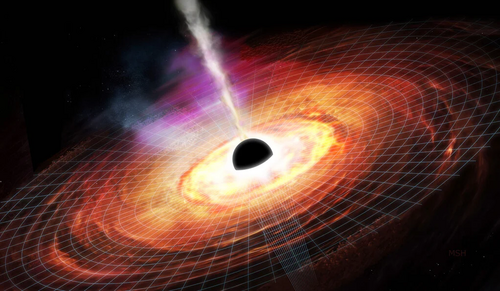
Yale’s Priyamvada Natarajan and colleagues have identified the oldest known X-ray quasar — offering compelling proof of a concept Natarajan helped pioneer.
Astronomers have found the oldest-known X-ray quasar in the universe — and its properties align exactly with predictions for a new class of distant objects made by Yale astronomer Priyamvada Natarajan and her research group.
In a new study in the journal Nature Astronomy, Natarajan and colleagues from Harvard and Princeton identified a celestial object, known as UHZ1, as the highest (or oldest) known “red shift” X-ray quasar in the universe. A separate study, to be published in The Astrophysical Journal Letters, provides an in-depth interpretation of the finding.
A quasar is a luminous, supermassive black hole. Its brightness comes from superheated gas that emits thermal radiation across the visible spectrum and beyond as gas falls into the black hole. The wavelength of light emitted by distant objects gets stretched to longer redder wavelengths as it reaches us and is quantified by a number called the redshift; a higher redshift denotes an older object whose light has traveled a greater distance to get to Earth.
According to the Nature Astronomy study, UHZ1 has a redshift of 10.1, which suggests that it takes light from UHZ1 13.72 billion light-years to reach Earth.
“It’s thrilling to be able to reveal the presence of a supermassive black hole, in place at the center of a galaxy a mere 450 million years after the Big Bang,” said Natarajan, the Joseph S. and Sophia S. Fruton Professor of Astronomy and professor of physics in Yale’s Faculty of Arts and Sciences and chair of the Department of Astronomy. “NASA’s Chandra space telescope detected X-rays from this distant quasar, which harbors an outsized black hole in its center.”
Beyond its significance as the oldest-known X-ray quasar, UHZ1 offers compelling proof that the early universe is “seeded” with heavy black hole seeds with large birth masses that likely formed from direct collapse — a concept pioneered and developed by Natarajan and her collaborators that has gained traction in recent years among astrophysicists.
Previously, it was thought that black holes could only form from “light seeds” created in the aftermath of exploding stars. But there was a timing problem with that theory — it did not leave enough time for black holes to grow into the behemoths that astronomers are now able to observe farther and farther back in time.
Yale’s Natarajan came up with a different theory. In papers published in 2006 and 2007, she developed a new model for the formation of “heavy” black hole seeds that could form in galaxies where star formation was suppressed — satellite galaxies that lie close to the galaxies that formed the first stars. In this model, large discs of gas in the satellite galaxies could collapse into heavy black hole seeds and then rapidly merge with their parent galaxies.
In 2017, Natarajan led a study with her Yale research group that suggested these supermassive black holes would have unique properties and be observable in the high-redshift universe — with help from the then-unlaunched (and now operational) James Webb Space Telescope (JWST). Natarajan predicted that over-massive black hole galaxies whose central black holes outweighed the stars in their host galaxies ought to be seen both by JWST and by the Chandra X-ray Observatory as X-ray quasars.
Natarajan even made note of potential candidate locations for high red shift, supermassive black holes, including a spot behind cosmic magnifying lenses, like the galaxy cluster named Abell 2744, where it has been found.
“UHZ1 is the first candidate that matches all our predicted properties for this transient class of over-massive black hole galaxies,” Natarajan said.
Six years later, the prediction has been borne out with observations.
A team led by Akos Bogdan of the Harvard Smithsonian Center for Astrophysics and Andy Goulding of Princeton combined recent data from the Chandra X-ray Observatory and JWST to peer behind galaxy Abell 2744. They utilized a method called gravitational lensing — another focus of Natarajan’s theoretical research — and treated Abell 2744 as a magnifying glass for looking even deeper into the cosmos.
There, they found Natarajan’s “heavy seed,” the oldest known X-ray quasar.
“JWST helped us find this extremely distant galaxy, and then deep Chandra observations revealed an X-ray bright supermassive black hole at its center,” Bogdan said. “Combining the unique multi-wavelength capabilities of NASA’s space telescopes made this discovery possible.”
Goulding added, “UHZ1 may only be the tip of the iceberg. The Webb Space Telescope has opened a new window on the early universe. It will no doubt help us find more UHZ1s, and ultimately understand if over-massive black holes were commonplace.”
Natarajan said there is now mounting evidence that nature likely produces black hole seeds via multiple scenarios, and it has required years of work modeling the details of these additional channels, pointing out where and how to find them feasibly.
“And now we’re seeing compelling first evidence,” Natarajan said. “This is an exciting intersection of topics, a culmination of all the things I have been working on.”
Support for the research came, in part, from the Black Hole Initiative at Harvard University, which is funded by grants from the John Templeton Foundation and the Gordon and Betty Moore Foundation.
This article is taken from the Yale News article of November 6, 2023 by Jim Shelton. See below for a link to the original story plus related links.